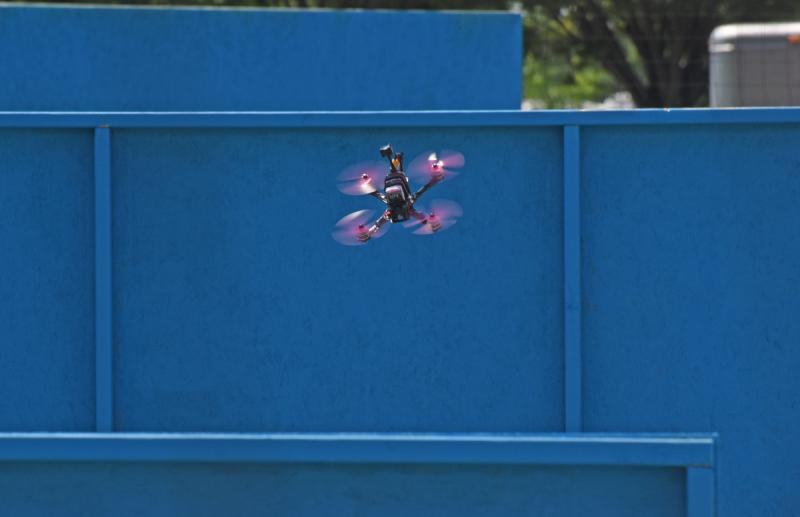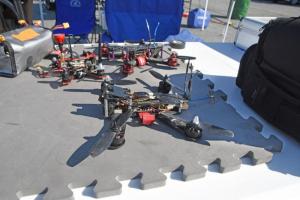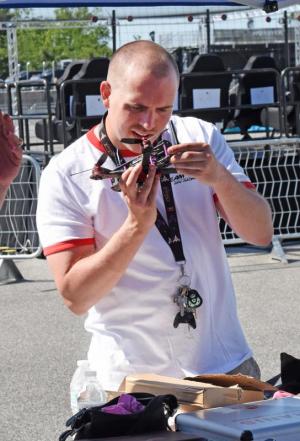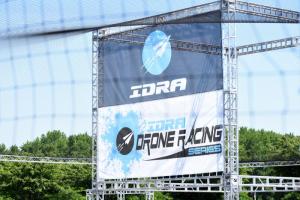Teams were hard at work in the days and weeks leading up to the big races at Dover International Speedway June 2-4. They were building their machines for speed and maneuverability, hoping to fine-tune them just right to come out victorious.
The International Drone Racing Association held its first event of the season last week, setting up a small track no larger than half a football field in the NASCAR Fan Zone between the speedway and Route 1.
Still in its infancy, drone racing has built a loyal following, attracting tech wizards, former military personnel and even some folks who helped put the rover on Mars.
“We all come from different backgrounds, but everyone is, in some way, their own little mad scientist,” said Joshua Fielder of Smyrna, a member of Team LiNX, an all-Delaware squad that competed in the event.
The rules of the sport vary depending on the hosting organization, but at the IDRA event in Dover, four teams competed simultaneously, zig-zagging, hurdling and sharply turning around gates on the course.
Each team consists of four pilots, and each has their chance to fly in a heat. The fastest teams advance. Team LiNX was eliminated in the first round due to technical difficulties, but it was the team’s first competition, so they weren’t too disappointed.
“It would have been nice to see how we could have done, but we'll take the loss and come back stronger next time,” said Team LiNX Captain Kristen Nelson of Millsboro. “I do feel bad for my teammates, but that's racing.”
Racing drones are unlike the drones most people buy to fly recreationally or for photography, as they are often much smaller and are capable to reaching 60 to 80 mph. Pilots wear goggles when racing, giving them a first-person view from the drone, a very unique perspective.
While some races are broken into classes based on battery cell size or length of propellers, the IDRA competition in Dover was an open event to all sizes, said Team LiNX’s Neil Little of Millsboro.
Like many drone racers, Little builds his drones from scratch. He is known as the Tin Man because of his soldering skills, but he didn’t always build his own custom drones.
“I started with an Airhawk from Walmart. It was $38.88,” he said, drawing laughter from his teammates who poked fun at him for remembering the exact price. “I started flying it around for about a month and then I bought toy after toy before I started researching it.”
Fielder followed a similar path. As a photographer, he purchased a photography drone and fell in love with it immediately.
“I’ve always been into superheroes, gaming and technology, so it was a natural step after flying them to want to make one,” he said.
Fielder credits the expansive online drone community for teaching him how to build his own machines. Fielder took advantage of YouTube videos and the knowledge of local drone enthusiasts to learn as much as he could.
“I got into this and all my time went to learning,” he said. “I had to learn about mechanical engineering, electrical engineering, aeronautical engineering. I had to learn a lot of stuff to really understand what’s happening with these machines.”
It was through the online drone community that Fielder connected with his LiNX teammates. They, along with many others in the state, often meet somewhere in Delaware, set up a track and enjoy a fun competition.
Waylon Sprowl of Felton, a former airplane pilot and the fourth member of Team LiNX, said the group typically sets up their courses with 5-foot-by-5-foot gates, the standard size for pilots competing in MultiGP races. MultiGP is a grassroots drone racing league focused on promoting and growing the sport.
To reduce the likelihood of harm to drones, the gates the group makes for practice consist of PVC pipe surrounded by swimming pool noodles.
The obstacles at the IDRA competition were not as forgiving. Metal structures similar to what one would see outlining a stage for a concert were set up on the course for pilots to dip, dive and slalom around.
“For most people, [practice] is nice and casual - not too slow, not too fast,” Sprowl said. “You just want to learn the course in and out and gradually pick up speed. You don’t want to crash on your first lap.”
For those who crashed at the IDRA event, it was game over until the race ended. Other organizations allow the pilot or a teammate to run out and get the drone with hopes of getting it back into the race.
The sport itself is growing, and it can often be found on one of the ESPN networks, YouTube or other internet-based outlets. IDRA has an agreement with Amazon to broadcast the Dover event on its AmazonPrime platform in the near future.
Sprowl said the technology is constantly changing for the better and it will only benefit the sport.
“There’s nowhere for it to go but up,” he said.
Fielder said he hopes to see drone racing evolve into a spectator sport.
“I think drone racing will be a hit when you have a track that’s going through the Grand Canyon or an area of Yellowstone National Park and the drones are the size of street bikes,” he said. “Out here, it’s cool, but it’s hard to track these little things when they’re moving at high speed.”
The IDRA is committed to growing the sport. The organization signed a three-year deal to host a competition in conjunction with the NASCAR race in Dover. They also have plans of hosting events worldwide in Portugal, South Korea, Russia, China and the Netherlands.
To learn more about IDRA, go to www.IDRA.co. To learn more about MultiGP, go to www.multigp.com.
Nick Roth is the news editor. He has been with the Cape Gazette since 2012, previously covering town beats in Milton and Lewes. In addition to serving on the editorial board and handling page layout, Nick is responsible for the weekly Delaware History in Photographs feature and enjoys writing stories about the Cape Region’s history. Prior to the Cape Gazette, Nick worked for the Delmarva Media Group, including the Delaware Wave, Delaware Coast Press and Salisbury Daily Times. He also contributed to The News Journal. Originally from Boyertown, Pa., Nick attended Shippensburg University in central Pennsylvania, graduating in 2007 with a bachelor’s degree in journalism. He’s won several MDDC awards during his career for both writing and photography. In his free time, he enjoys golfing, going to the beach with his family and cheering for Philadelphia sports teams.



























































